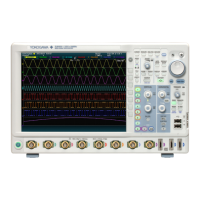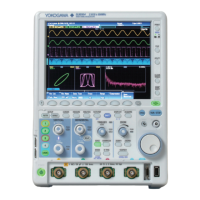6-4
IM DLM3054-01EN
Sampling Mode (Sampling Mode)
The instrument samples data using a 2.5 GS/s A/D converter, so the maximum sample rate in normal sampling
mode (real-time sampling mode) is 2.5 GS/s.
If you decrease the time axis setting when measuring fast phenomena, the sample rate will reach its maximum
rate (2.5 GS/s) at a certain point. If you decrease the time axis setting further, the number of displayed points
decreases (the display record length decreases).
The instrument has two modes for interpolating between deficient data points. Set the sampling mode when
you want to make measurements by setting a sample rate that is higher than the real-time sampling mode’s
maximum sample rate (2.5 GS/s).
• Interpolation mode: Interpolates between data points using the (sinx)/x function. This mode is effective for
single-shot signals.
• Repetitive sampling mode: Interpolates through random sampling. This mode is effective for repeating signals.
Relationship between the Time Scale, Record Length, and Sample Rate
The relationship between the time scale, record length, and sample rate is as follows:
When the record length and the time axis are set so that the sample rate is at the maximum rate, if you decrease
the time axis setting further, the record length is reduced.
Sample rate = Record length/(time scale [s/div] × 10 [div])
Real-Time Sampling Mode (Realtime)
When you change the time axis setting, the sample rate changes. You can sample data at a maximum sample
rate of 2.5 GS/s (1.25 GS/s when High Resolution mode is on).
In this mode, the instrument can only display waveforms up to the frequency that corresponds to one-half
the sample rate, in accordance with the sampling theorem.* Therefore, this mode is suitable for observing
waveforms whose frequency is lower than one-half the sample rate.
* If the sample rate is comparatively low with respect to the input signal frequency, the harmonics contained in
the signal are lost. When this happens, some of the harmonics will be misread as low-frequency waves due
to the effects described by the Nyquist sampling theorem. This phenomenon is called aliasing. You can avoid
aliasing by acquiring waveforms with the acquisition mode set to Envelope.
Interpolation Mode (Interpolation)
In Interpolation mode, the instrument interpolates the data sampled at 2.5 GS/s up to 100 times using the (sinx)/x
function.
This essentially increases the sample rate to up to 250 GS/s.
The interpolation mode is effective for single-shot signals. If the input signal frequency is high relative to the
sample rate (2.5 GS/s here), aliasing may occur.
You can use the history feature in Interpolation mode.
Repetitive Sampling Mode (Repetitive)
In this mode, one waveform is created from several cycles of a repeating signal. This is equivalent to sampling
the signal at a higher sample rate than the actual sample rate. The equivalent sample rate is 250 GS/s
maximum.
The instrument uses random sampling, which takes advantage of the fact that the time difference between the
trigger point and sampled points is random. The instrument realigns the trigger point each time it acquires a
waveform.
This mode is effective for repeating signals, and aliasing rarely occurs.
You cannot use the history feature in Repetitive Sampling mode.
6 Waveform Acquisition

